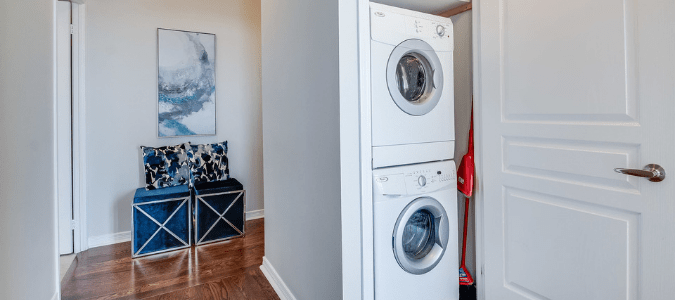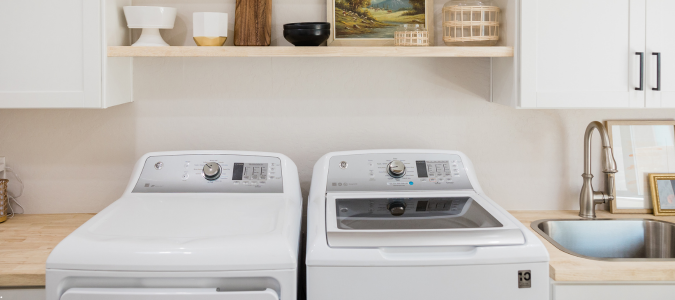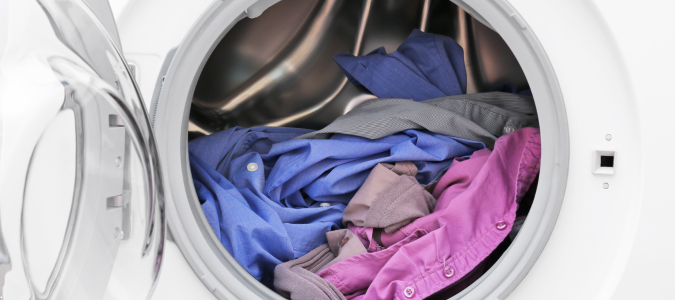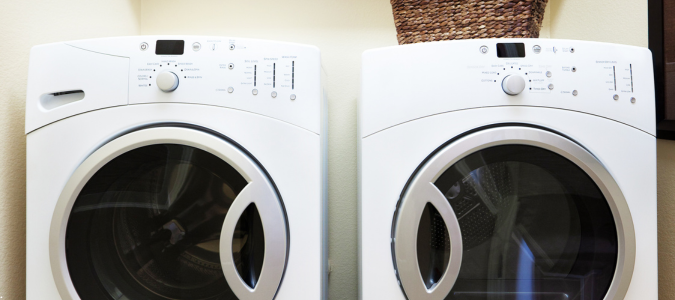Your dryer can leak water for many reasons. Most of the time, it’s due to a clogged ventilation system or another common issue that can be easily resolved.
A leaky dryer can be more than just an inconvenience. It can sometimes indicate a more serious issue with your appliance. From clogged vents to faulty seals, there are several common reasons moisture may be building up. Learn how to determine if this issue can be resolved on your own or if it’s time to call in an appliance repair specialist.
Five Reasons Why Your Dryer Is Leaking Water
There are typically five common reasons why your dryer could be leaking water, which include:
- Blocked ventilation system
- Condensation in the exhaust duct
- Faulty lint filter
- Overfilled dryer
- Unleveled dryer
Let’s examine these a bit more. Before attempting any of these fixes, turn off your dryer and unplug it from the power source.
Blocked Ventilation System
Your dryer generates hot, humid air as it dries your clothes. As moisture evaporates from the clothes, that hot air needs somewhere to go. Dryers are designed to release air through the vent system. If the vent is blocked, air can’t exit properly. Instead, it will condense inside the dryer drum, causing leakage.
You can fix a blocked ventilation system by cleaning your dryer vent. Here are easy steps to follow:
- Move the dryer away from the wall to access the air vent.
- Disconnect the vent hose by removing the screws holding it in place.
- Clean the vent hose using a vacuum cleaner.
- Check the wall vent opening for lint buildup and clean up any buildup.
- Reconnect the vent hose, plug the dryer back in and check if air is flowing freely outside.
If your vent hose is severely clogged or damaged, contact an appliance repair specialist.
Condensation in the Exhaust Duct
When the exhaust duct passes through a cold area of your home, warm air condenses into water droplets. This issue typically only occurs during the winter months.
You can troubleshoot a minor condensation problem by doing the following:
- Clean the lint filter to improve airflow.
- Inspect the vent flap outside your home to confirm it opens easily when you turn on your dryer.
- Clean the exhaust duct to remove lint buildup.
If the problem persists or you need to access hard-to-reach areas, contact ABC Home & Commercial Services.
Faulty Lint Filter
A lint filter keeps your dryer safe from blockages. This mesh screen catches lint, fibers and debris from your clothes during drying, preventing them from entering the air vent.
Over time, the lint filter can develop cracks and holes. It can also get damaged by a buildup of residue from fabric softeners. When this happens, lint escapes the vent, causing moisture to accumulate and leak.
If you notice visible tears in the mesh screen, dryer leakage and longer drying times, reach out to an appliance repair professional.
To fix a faulty lint filter, an expert will:
- Get a new lint filter that’s specifically made for your dryer model.
- Remove the old lint filter from its slot and replace it with the new one.
- Vacuum the dryer vent and internal ductwork.
- Reassemble the dryer and turn it on to check for leakage.
Overfilled Dryer
When it comes to troubleshooting a leaky dryer, an overload is the simplest issue to fix. Overloading your dryer can strain the door seal and other components, potentially causing damage. It can also weaken mechanical components and cause the system to malfunction. Sometimes, your dryer won’t start at all, or it can stop mid-cycle.
You can prevent or fix a dryer overload by:
- Not putting too many items in your dryer.
- Following the manufacturer’s instructions on load capacity.
Unleveled Dryer
If your dryer isn’t sitting flat on the floor, moisture collects unevenly and pools in the wrong spots, causing leakage.
Here’s how to tell if your dryer isn’t level:
- The dryer wobbles when you push on it.
- It visibly tilts to one side.
- It moves around when you turn it on.
- It emits a loud rumbling or vibrating sound when in operation.
- You find a water puddle beneath it during or after a drying cycle.
An unlevel dryer is among the easiest issues to fix. You just need to adjust the legs to make sure it sits evenly on the floor. Some dryers have adjustable feet. You can twist them by hand or use a wrench to level the dryer so it no longer wobbles.
What To Do if Your Dryer Is Leaking
If you notice your dryer is leaking water, stop using it until you determine the cause of the leak. Leaking water can cause significant damage to your dryer.
Here’s what you should do if your dryer is leaking water:
- Inspect the lint trap for clogs and visible signs of damage.
- Check for a musty or sour smell when you turn on the dryer.
If your dryer is leaking water or if there is a smell that doesn’t seem right, it’s best to call in an appliance repair specialist.
Why Is There a Puddle in My Dryer?
If you find a puddle in your dryer, it’s mostly due to condensation. Let’s take a close look at how this happens:
- Your dryer generates heat and moisture during a drying cycle.
- The exhaust vent carries this moist, hot air outside your home.
- The hot air meets a cold surface, such as a metal drum or vent duct, which prevents it from escaping properly.
- The hot air turns into water droplets.
These droplets build up and form a puddle in your dryer. An appliance repair specialist best handles condensation issues. But, before getting professional help, here are some initial steps you can take to address this issue:
- Dry the puddle.
- Check to see if air is exiting through the vent.
- Clean the vent if you find any dirt buildup.
- Evaporate leftover moisture by running an empty cycle for 15 minutes.
If these fixes don’t work, contact an appliance technician.
What Is the Most Common Dryer Failure?
The most common dryer failure in electric dryers is typically related to the heating element. For a gas dryer, you might experience a gas valve coil failure.
These components are responsible for generating the heat you need to dry your clothes. When a dryer develops an issue, your clothes will stay damp, regardless of how long you run them in the dryer. This means you’ll spend more money on energy bills because your dryer runs for longer than it should.
Here are other issues you’ll likely encounter while using a dryer:
- Faulty thermostat
- Blown thermal fuses
- Clogged vents
Let’s cover these a bit more.
Faulty Thermostat
A thermostat controls the temperature of your dryer. When a thermostat becomes faulty, it sends the wrong signal to your dryer and causes heating problems. In some cases, your dryer won’t start. If it does turn on, it could overheat.
Blown Thermal Fuses
Think of a thermal fuse as your dryer’s first line of defense against overheating. Once a thermal fuse detects overheating, it cuts off power to the system. If your thermal fuse blows, you might find your dryer not heating at all, or it may break down.
Clogged Vents
If your clothes take longer to dry, it’s worth checking for clogs in your vent. Humid air escapes your dryer through a vent. However, your vent can become clogged by clothes fibers, dust and debris. This makes it difficult for air to exit your appliance, resulting in longer drying cycles.
Dryer Leaking Water? Don’t Ignore the Signs
Basic maintenance, such as cleaning your air vent, checking the lint filter and inspecting door seals, can help you detect a leak. If you suspect there is a leak in your home or notice that your dryer smells musty or sour, call in professional help.
An appliance repair specialist is the best person to resolve any issues with your washing machine or dryer. They have the tools and expertise to accurately diagnose the issue and fix it. This will protect your appliance from further damage.
ABC Can Resolve Your Appliance Problems
If you are experiencing issues with your dryer, trust the appliance repair specialists at ABC Home & Commercial Services to get to the bottom of it. Whether you notice your dryer leaking water, an unpleasant odor or any other issue, our team can properly diagnose any dryer or washer problem and fix it.




